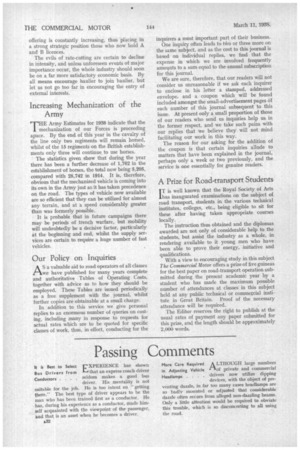Passing Comments
Page 34

Page 35

If you've noticed an error in this article please click here to report it so we can fix it.
It is Best to Select L'XPERIENCE has shown Bus Drivers from 1--a that an express coach driver Conductors . . . . seldom makes a good bus driver. His mentality is not suitable for the job. He is too intent on " getting there." The best type of driver appears to be the man who has been trained first as a conductor. He has, during his experience as a conductor, made himself acquainted with the viewpoint of the passenger, and that is an asset when he becomes a driver. A32 More Care Required A LTHOUGH large numbers in Adjusting Vehicle r-Lof private and commercial Headlamps . . • drivers now utilize dipping devices, with the object of preventing dazzle, in far too many cases headlamps are so badly mounted or adjusted that considerable dazzle often occurs from alleged non-dazzling beams. Only a little attention would be required to obviate this trouble, which is so disconcerting to all using the road.
The Height of WE received not long ago Caution—An Amusing " some samples of hardened Injunction steel self-tapping screws, and were amused to read on the box in which they were packed the injunction "do not crush." Anything less liable to damage from crushing than screws which are made to be forced into plain holes in steel—a process that must subject them to a very considerable crushing stress—would be hard to imagine.
Reduction of Underp EPRESENTATIONS have
clearance Length in been made to the Minister Trolteybuses. . of Transport in respect of the extent of the ground clearance required in the case of four-wheeled trolleybuses. The Minister has. stated that he does not think that there is justification for a general relaxation of the requirement of an under-clearance of 10 ins, for a length of 14 ft. 6 ins. In the case, however, of trolleybuses where difficulties exist owing to inadequate height under bridges, he would be prepared to consider a reduction of the length required from 14 ft. B ins. to 12 ft. 6 ins., on application by the operators concerned before the vehicles are ordered.
Extremes of Heat THE modern motor vehicle and Cold in Vehicle a may be the product of both Production . . . extreme heat and intense cold.
In the manufacture of the Ford chassis, for instance, the highest temperature is used in the production of valve-seat inserts of hard alloy-steel, which is poured in at a temperature of 3,000 degrees F. To enable these to be fitted into the exhaust ports, they are contracted in refrigerators containing liquid oxygen at a temperature of minus 170 degrees F. Metal for cylinder blocks is poured at 2,580 degrees F., whilst the cold testing of engines and alloys is carried out at 16 degrees F., which means 16 degrees of frost.
















































































